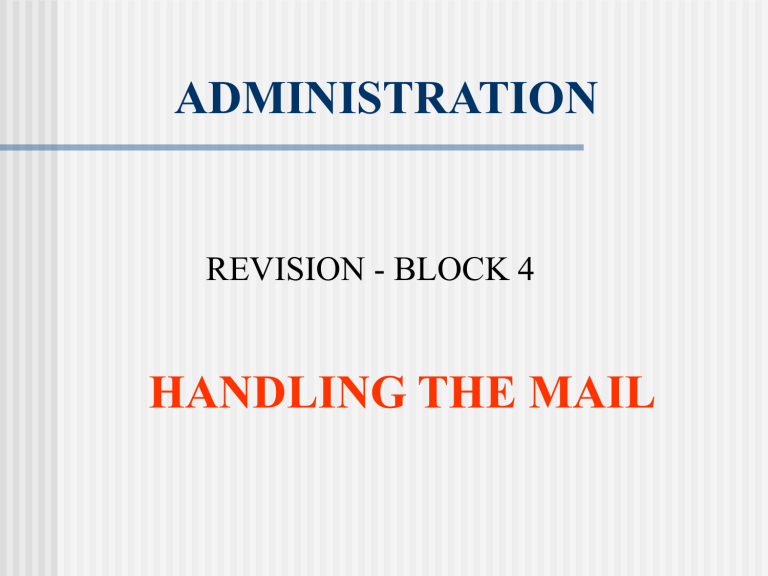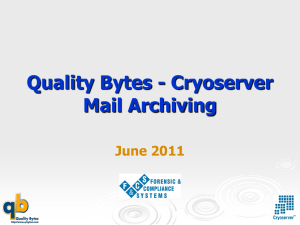Admin Revision 4

ADMINISTRATION
REVISION - BLOCK 4
HANDLING THE MAIL
HANDLING THE MAIL
This is an important task because the work of the organisation and its staff mainly stems from the communications it receives.
Mail falls firstly into 2 categories: internal - from inside and external - from outside the organisation and then into 2 other categories: traditional - hand delivered and electronic
Examples:
- via telephone line
Internal traditional - memos, reports, forms, notices
Internal electronic - e-mail eg from computer to computer
External traditional - anything sent by post and courier
External electronic - e-mail, fax
INTERNAL MAIL
Mail which circulates and stays within an organisation
Large organisations will have a system for circulating mail around its branches and departments.
This can be done manually by: messenger - where someone delivers messages transit envelope - for passing messages round photocopier - make one copy for each person routing/circulation slip pigeon holes
- the names of those to read a document are written on a slip and attached to it
- boxes into which messages are placed to be collected notice board - staff notices can be posted on the board to be read and electronically by:
E-mail - received into private electronic ‘mail boxes’ on computer fax - for communications between different branches
EXTERNAL MAIL
Mail sent into and out of an organisation
In a small firm the receptionist will deal with the mail.
A large organisation dedicates a whole department to mail handling.
A mail department will have 2 sections, one to handle
Incoming mail
These 2 sections have equipment suited to speeding up the process of mail handling.
Here are some examples of mail room equipment
In the incoming and the other mail section letter opening machine
Outgoing mail
In the outgoing mail section folding and inserting machine date stamp remittances book franking machine postages book pigeon holes trolley shredder addressing machine electronic postal scales
INCOMING MAIL PROCEDURES
Sort mail into 3 bundles
The rest Urgent - deal with these first Private and confidential
Open envelopes with letter opener
Remove all contents
Deliver unopened
Date stamp contents
Check and enter any remittances in remittances book and pass them on to the cashier
Check and attach all other enclosures to letters
Photocopy/attach circulation slips to letters to be seen by more than one person
Sort into departments
Deal with as for urgent
Deliver to appropriate in trays
OTHER INCOMING MAIL
Incoming computer E-mail is normally checked by the individuals who receive it directly into their ‘inbox’.
Incoming Fax messages should be delivered to those concerned either: by messenger or by placing them in the appropriate pigeon hole
Incoming voice mail ie telephone messages, should be written down and placed in the appropriate person’s pigeon hole.
DEALING WITH OUTGOING MAIL
Outgoing mail should be picked up from out trays several times throughout the day.
This will spread the workload over the afternoon and prevent having to work late.
All outgoing mail should be recognisable from documents to be filed which would bear a release mark.
Outgoing mail can be sent by various means:
Traditional outgoing mail:
First or second class post
Recorded - for sending
Delivery legal documents
Electronic outgoing mail:
Fax
Computer e-mail – usually done by the sender
Voice Mail - sent by the sender
Courier
OUTGOING MAIL PROCEDURES
Collect mail from out trays regularly
Check for signature
Prepare necessary envelopes
Check for and insert enclosures with letters
Sort into first class, second class and special delivery
Weigh letters/packets heavier than standard postage
Apply appropriate postage stamp or franked impression
Enter postage used in Postages Book
Take to post office in separate categories
Send fax messages
Print out fax report as proof of sending
Now answer the following questions in sentences on paper.
1 Name 4 different types of mail.
2 Why is mail important to any organisation?
3 What is the difference between internal and external mail ?
4 Suggest 2 methods of circulating mail.
5 In which section of the mail room is the remittances book?
6 What exactly is a date stamp used for?
7 An organisation suspects postage stamps are being stolen.
Name a machine which solves this problem and say why.
8
How should mail marked ‘ private and confidential’ be processed?
9 What is the importance of a remittances book ?
10 How should important legal documents be sent in the post?
Now check your answers with the solution and note your score.
PROBLEM SOLVING
Answer the following on paper.
The outgoing mail section of your mail department struggles to complete their work before 5.30 each evening.
Suggest 5 procedures and/or pieces of equipment which could speed up the process and explain in full how it will help the outgoing mail staff to leave the workplace by 5.00 pm.






